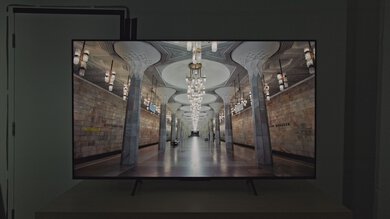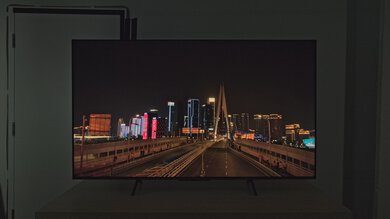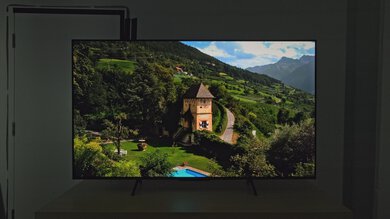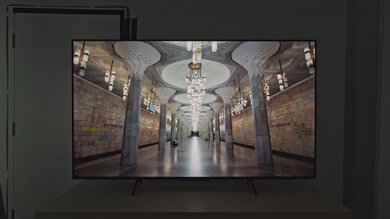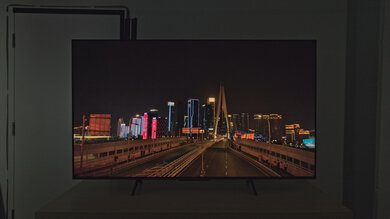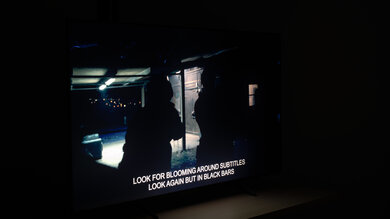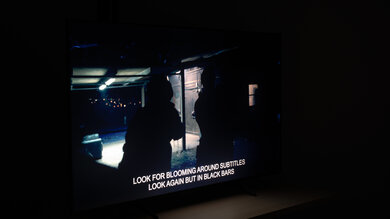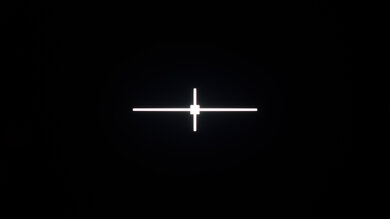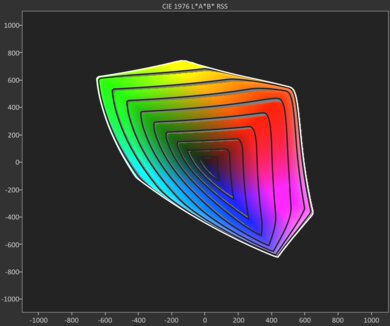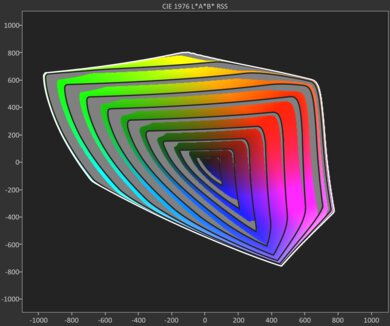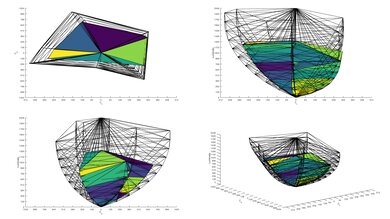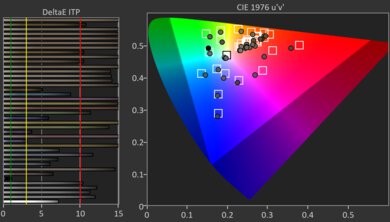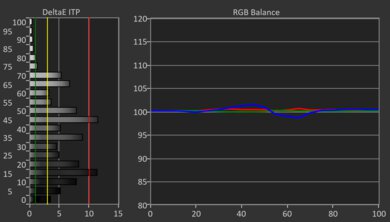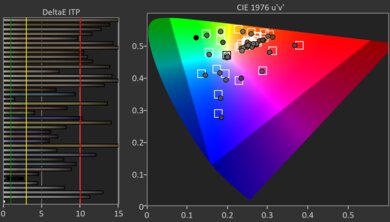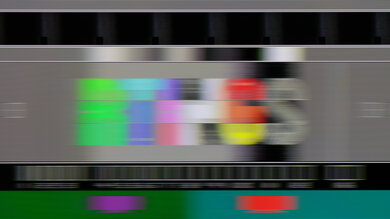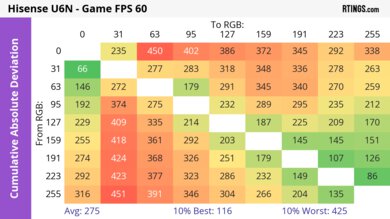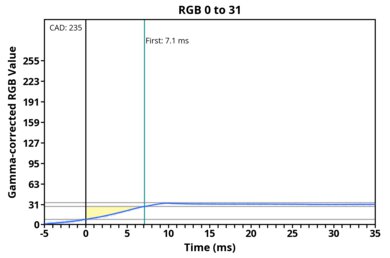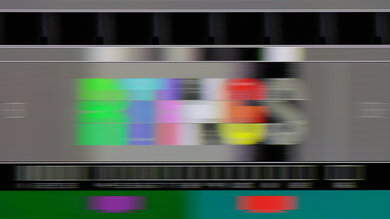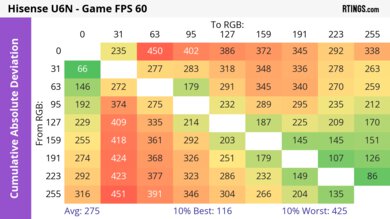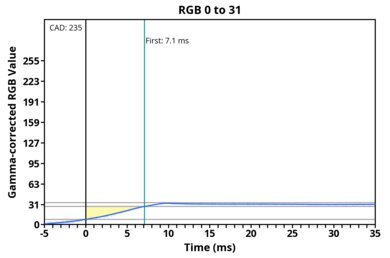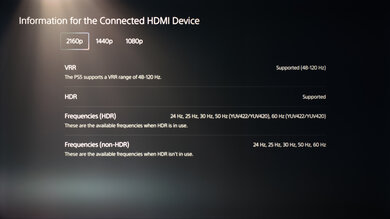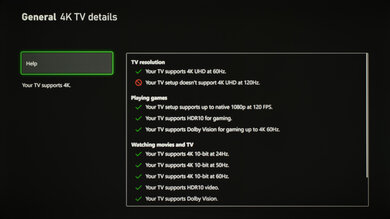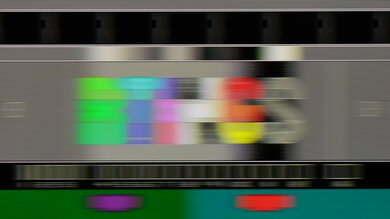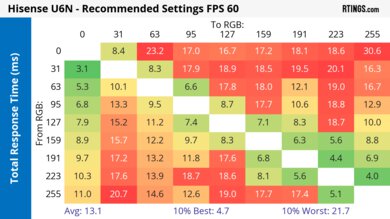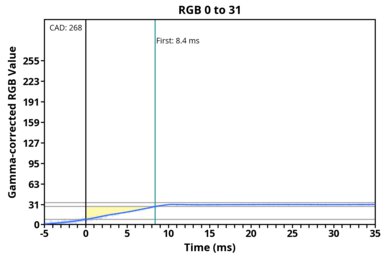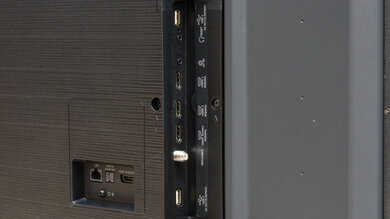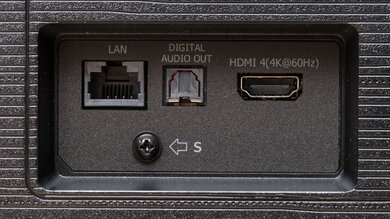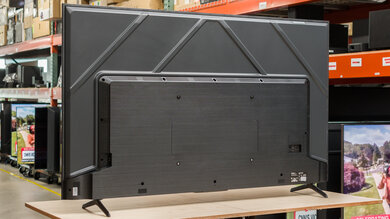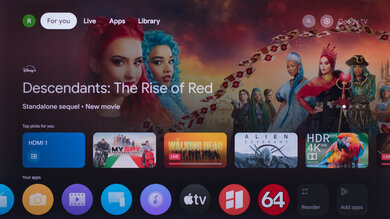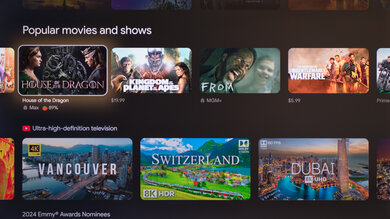The Hisense U6/U6N is a budget-friendly TV released in 2024 and replaces the Hisense U6/U6K. It's the entry-level model in Hisense's 2024 ULED lineup, sitting below the Hisense U7N and the Hisense U8/U8N. It doesn't have the same gaming features as the more expensive models, like HDMI 2.1 bandwidth and black frame insertion, but it's still capable of 4k @ 60Hz with VRR and HDR enabled, and you can also game in up to 1440p @ 120Hz if you'd prefer a higher frame rate. The TV does have a local dimming feature meant to improve contrast, and it uses Hisense's Hi-View Engine chipset that's designed to optimize certain settings to improve the user's viewing experience. The TV uses the Google TV interface, which is loaded with apps and offers smart features like voice control, and it has a built-in 20W 2.0 channel speaker system. We bought and tested the 65-inch model, but it's available in four sizes total: 55-inch, 65-inch, 75-inch, and 85-inch.
Our Verdict
The Hisense U6 is okay for mixed usage. It looks alright in a dark room due to its deep blacks and okay colors, but it's dim in HDR, so HDR content lacks some impact. The TV is bright enough in SDR to fight glare from some overhead lights, but it's not quite bright enough for very sunny rooms, and direct reflections are distracting. The TV doesn't have modern gaming features like 4k @ 120Hz, but it still has VRR and supports up to 1440p @ 120Hz. Its viewing angle is unremarkable, so the TV isn't a good option for wide seating arrangements.
Decent SDR brightness helps it overcome glare in moderately lit rooms.
Superb black uniformity and decent contrast for deep blacks.
Blacks remain deep and colors stay vibrant in a room with ambient lighting.
Direct reflections are distracting.
Image degrades when viewed from the sides.
Sub-par HDR brightness means highlights don't stand out the way they should in HDR content.
The Hisense U6 is an alright TV for a home theater. It has decent contrast due to its local dimming, so even though there's some blooming around highlights and subtitles, you still get deep blacks. Darker colors are displayed well, but the TV struggles to display brighter ones, so colors look a bit muted. Unfortunately, the TV has sub-par HDR brightness, so highlights don't pop out the way they should in HDR content. Furthermore, HDR content is dimmer than intended due to its poor PQ EOTF tracking, so the TV doesn't follow the filmmaker's intent.
Superb black uniformity and decent contrast for deep blacks.
Good upscaling performance.
Poor PQ EOTF means HDR content looks dimmer than intended.
Sub-par HDR brightness means highlights don't stand out the way they should in HDR content.
The Hisense U6 is satisfactory for a bright room. The TV has decent SDR brightness, so it fights some glare from indirect light sources. However, it's not bright enough for more well-lit rooms, and reflections from light sources opposite the screen are distracting. Fortunately, the TV's image quality is mostly unaffected by ambient light, so you still get deep blacks and vibrant colors when your lights are turned on.
Decent SDR brightness helps it overcome glare in moderately lit rooms.
Direct reflections are distracting.
The Hisense U6 is okay for watching sports. It has decent SDR brightness, so it fights some glare from overhead lights. Unfortunately, it's not bright enough for well-lit rooms, and direct light sources facing the screen are distracting. The TV's color vibrancy is adequate for most sports, so jerseys look vivid enough to enjoy. Sadly, the TV's uniformity is mediocre, and you see some dirty screen effect in sports with large areas of uniform color, like hockey or soccer. Finally, its viewing angle is unremarkable, so the TV's image quality degrades when viewed from more aggressive angles, making it a bad choice for wide seating arrangements.
Decent SDR brightness helps it overcome glare in moderately lit rooms.
Good upscaling performance.
Direct reflections are distracting.
Image degrades when viewed from the sides.
- Poor low-quality content smoothing.
The Hisense U6 is an alright gaming TV. It supports 4k @ 60Hz with VRR for a nearly tear-free gaming experience, but you can also game in up to 1440p @ 120Hz if you prefer a higher frame rate over resolution. Unfortunately, the TV's VRR feature doesn't work @ 120Hz. It has low enough input lag for a responsive feel, but its slow pixel transitions mean fast motion is blurry. The TV has very good black levels, so the image has depth to it. Colors look okay overall, but they are a bit muted in HDR, and the sub-par HDR brightness means highlights don't pop out the way they should.
Superb black uniformity and decent contrast for deep blacks.
Low input lag.
Slow pixel transitions leads to blurry motion in games.
- VRR doesn't work in 1440p and 1080p @ 120Hz.
Sub-par HDR brightness means highlights don't stand out the way they should in HDR content.
The Hisense U6 has unremarkable brightness overall. Its SDR brightness is decent enough to fight glare in moderately lit rooms. However, its sub-par HDR brightness means highlights only stand out a bit in darker HDR scenes, and brighter scenes lack impact.
Decent SDR brightness helps it overcome glare in moderately lit rooms.
Sub-par HDR brightness means highlights don't stand out the way they should in HDR content.
The Hisense U6 has very good black levels. The TV's decent contrast and superb black uniformity mean it displays deep blacks, which give the image solid depth. Its lighting zone precision is satisfactory, but there's still some noticeable blooming around subtitles and highlights in darker scenes.
Superb black uniformity and decent contrast for deep blacks.
Blacks remain deep and colors stay vibrant in a room with ambient lighting.
The Hisense U6 has okay colors overall. Its SDR color volume is decent, so most SDR content looks as vibrant as it should. The accuracy of colors in SDR is mediocre, so enthusiasts will want to get the TV calibrated. The TV's HDR color volume is adequate, but bright colors look a bit dull and muted. Color accuracy in HDR is okay, but the image is overly cool, and some colors are undersaturated.
Decent SDR color volume for vibrant colors in most SDR content.
Colors are inaccurate in SDR out of the box.
Note: We're in the process of improving our tests related to image processing, but this score should give you a general idea of how a TV performs overall with its image processing capabilities.
The Hisense U6 has mediocre image processing overall. It has good upscaling, so low-resolution content doesn't look too soft. Unfortunately, low-bitrate content has visible artifacts present due to the TV's poor low-quality content smoothing. Color gradients look decent, but you do see some banding in dark grays, greens, and blues. Finally, HDR content is dimmer than intended due to the TV's poor PQ EOTF tracking, so this model doesn't stay true to the filmmaker's intent.
Good upscaling performance.
Poor PQ EOTF means HDR content looks dimmer than intended.
- Poor low-quality content smoothing.
The Hisense U6 has alright responsiveness in its dedicated gaming mode. It only has HDMI 2.0 bandwidth, so you're limited to 4k @ 60Hz with VRR. However, the TV offers up to 1440p @ 120Hz without VRR, so you have options. It has low enough input lag for a responsive gaming experience, but its slow pixel transitions lead to blurry motion.
Low input lag.
Slow pixel transitions leads to blurry motion in games.
- VRR doesn't work in 1440p and 1080p @ 120Hz.
We're in the process of fixing the way we evaluate a TV's overall motion handling. This section is currently broken, and the score isn't indicative of how well the Hisense H6N handles motion overall.
Performance Usages
Changelog
- Updated Jul 09, 2025: Converted to Test Bench 2.0.1. We did this to fix an issue with our scoring in the Supported Resolutions section, since TVs with a refresh rate higher than 144Hz were being penalized for not supporting 144Hz.
- Updated Jul 09, 2025:
We wrote text for the new tests and rewrote text throughout the review after updating pre-existing tests and scores for Test Bench 2.0.
- Updated Jul 09, 2025: We converted the review to Test Bench 2.0. With this new methodology, we've added new tests to expand the scope of our testing, adjusted our scoring to better align with current market conditions, and added performance usages that group related tests together to give more insight into specific aspects of a TV's performance. You can find a full list of changes in the TV 2.0 changelog.
- Updated Apr 02, 2025:
We mentioned the newly reviewed TCL QM6K in the Contrast section of this review.
Check Price
Differences Between Sizes And Variants
We bought and tested the 65-inch Hisense U6N, and the results are also valid for the 55-inch model. The 75-inch model uses an ADS Pro panel, so it performs a bit differently than the other sizes, with worse contrast but a better viewing angle. The 85-inch model comes with Hisense's older remote, runs version 11 of the Google TV OS instead of version 12 like the other sizes, and is missing certain settings that the other sizes have; although we expect it to perform similarly overall, our results aren't valid for it.
In Canada, the TV is known as the Hisense U68N and performs the same. There are similarly-named international models, like the U6NAU in Australia, but these models perform differently from the North American U6N, so our results aren't valid for them.
| Size | US Model | Local Dimming Zones | Panel Type |
|---|---|---|---|
| 55" | Hisense 55U6N | 160 | VA |
| 65" | Hisense 65U6N | 240 | VA |
| 75" | Hisense 75U6N | 240 | ADS Pro |
| 85" | Hisense 85U6N | 512 | VA |
Our unit was manufactured in February 2024, as seen on the label.
Popular TV Comparisons
The Hisense U6/U6N is one of the best budget-friendly TVs on the market released in 2024 and outperforms similarly priced models from brands like LG, Samsung, and Sony. Its standout feature is its contrast, so the TV delivers deep blacks that rival those found on much more expensive TVs. It's comparable to TVs like the TCL Q5/Q550G QLED and the TCL Q6/Q650G QLED, but the U6N provides much better overall picture quality than the TCL models, mainly due to its local dimming feature. If you're looking for an affordable TV that looks good and performs well overall, the U6N is hard to beat.
For more options, check out our recommendations for the best TVs under $1,000, the best bedroom TVs, and the best TVs for gaming.
The Hisense U6N provides better overall picture quality than the Hisense QD7N. The U6N has a good local dimming feature to improve its black levels, and it gets brighter in HDR, so it delivers a much more impactful HDR experience. On the other hand, the QD7 is the better option for gamers since it has HDMI 2.1 bandwidth, 4k @ 144Hz, and better VRR functionality.
The Hisense U6N is better than the Hisense U6K in most ways. The U6N has a higher contrast ratio and much better black uniformity for deeper blacks in a dark room, and its slightly better HDR brightness makes highlights stand out a bit more in HDR content. The U6N also has better SDR brightness, meaning it overcomes more glare in a room with the lights on. Additionally, the U6N has a faster response time for less blur behind quick motion, supports DTS audio formats, and has slightly better upscaling capabilities. On the other hand, the U6K is the more accurate TV in both SDR and HDR due to its much better pre-calibration accuracy and better PQ EOTF tracking.
The TCL Q750G is better than the Hisense U6N. The TCL has better SDR brightness, meaning it overcomes more glare in a bright room. The TCL also has better HDR brightness and PQ EOTF tracking, so it displays brighter highlights and stays closer to the content creator's intent with HDR content. The TCL has HDMI 2.1 bandwidth, supports up to 4k @ 144Hz, and has a better VRR feature, so it's a better option for gamers looking to get the most out of their modern consoles or gaming PCs.
The Hisense U8N is much better than the Hisense U6N. The U8N has a more effective local dimming feature, which delivers very deep blacks that are approaching those found on OLED TVs, with less blooming. The U8N also has much better SDR brightness and reflection handling, meaning it overcomes glare in the brightest of rooms. When it comes to HDR, the U8N has much better HDR brightness, which means it displays brighter highlights that really pop out, and its wider color gamut and better color volume deliver brighter and more vibrant colors. If you're looking for a Hisense TV to pair with your Xbox, PS5, or gaming PC, the U8N is the better choice due to its faster response time, HDMI 2.1 bandwidth, and support for up to 4k @ 144Hz.
Test Results

The Hisense U6 has sub-par HDR brightness. Some highlights stand out a bit in darker scenes, but the TV's HDR brightness isn't good enough to display brighter highlights with impact.
These measurements are after calibrating the HDR white point with the following settings:
- HDR Picture Mode: Filmmaker Mode
- Local Dimming: High
- Peak Brightness: High
- Brightness: 100
- Contrast: 50
- Black Level: 0
- Dark Detail: Off
- Gamma: ST2084
- Active Contrast: Off
- Dynamic Tone Mapping: Off
- Color Temperature: Warm 1
Below are the results with Dynamic Tone Mapping set to 'On,' which increases peak brightness at the cost of accuracy.
- Hallway Lights: 412 cd/m²
- Yellow Skyscraper: 335 cd/m²
- Landscape Pool: 284 cd/m²
There's no noticeable difference in HDR brightness when the TV is set to PC/Game Mode.
These measurements are after calibrating the HDR white point with the following settings:
- HDR Picture Mode: HDR Game
- Local Dimming: High
- Peak Brightness: High
- Brightness: 100
- Contrast: 50
- Black Level: 0
- Dark Detail: Off
- Gamma: ST2084
- Active Contrast: Off
- Dynamic Tone Mapping: Off
- Color Temperature: Warm 1
Below are the results with Dynamic Tone Mapping set to 'On,' which increases peak brightness at the cost of accuracy.
- Hallway Lights: 411 cd/m²
- Yellow Skyscraper: 340 cd/m²
- Landscape Pool: 308 cd/m²
The Hisense U6N has decent SDR brightness, and it overcomes some glare in well-lit rooms.
These measurements are after calibration with the following settings:
- Picture Mode: Theater
- Local Dimming: High
- Peak Brightness: High
- Contrast: 45
- Gamma: 2.2
- Color Temperature: Warm 1
- Active Contrast: Off
The Hisense U6N has decent contrast. The TV's native contrast ratio is outstanding, but with local dimming on 'High,' the TV delivers deep blacks in a dark room. They mostly stay deep when bright highlights are also on screen. If you want even better contrast, look at the TCL QM6K instead.
The TV has decent overall lighting zone transitions, but it struggles with fast-moving content. There's noticeable haloing, and the leading edge of bright, quick-moving objects is visibly dimmer.
The TV has decent SDR color volume. Like almost any TV, it covers the full range of colors in the BT.709 color space, but it also has very good coverage of the wider DCI-P3 color space. It has mediocre coverage of the widest BT.2020 color space, as its color volume isn't good enough to display most colors.
| Volume ΔE³ | DCI-P3 Coverage | BT.2020 Coverage |
|---|---|---|
| L10 | 86.95% | 66.39% |
| L20 | 88.87% | 66.46% |
| L30 | 89.91% | 67.02% |
| L40 | 89.74% | 68.74% |
| L50 | 89.56% | 68.95% |
| L60 | 87.98% | 65.40% |
| L70 | 85.86% | 55.63% |
| L80 | 85.43% | 52.89% |
| L90 | 85.94% | 53.85% |
| L100 | 92.33% | 75.72% |
| Total | 87.75% | 61.73% |
The TV has adequate color volume. Dark saturated colors are displayed well due to the TV's fantastic contrast. On the other hand, the TV doesn't display most colors at high luminance levels.
The Hisense U6N has unremarkable pre-calibration SDR accuracy. Its white balance is bad, with greens underrepresented and blues and reds overrepresented in most shades of gray. Gamma is close to our target of 2.2, but most scenes are displayed darker than intended. Its color accuracy is alright, but there are inaccuracies with all colors, and whites and lighter shades of most colors are noticeably inaccurate. Fortunately, the TV's color temperature is almost perfectly at our target of 6500K.
If you don't need the advanced features of the U6N and are really bothered by its poor pre-calibration SDR accuracy, the cheaper Hisense A7N is much more accurate in SDR.
The TV has fantastic SDR accuracy after calibration, and the TV is easy to calibrate. Any issues with white balance are gone, and the gamma is close to perfect. Color accuracy is outstanding, with only some minor inaccuracies that aren't noticeable to most people.
See our full calibration settings.
The Hisense U6 has okay HDR accuracy before calibration. Blues are overrepresented in most shades of gray, while reds are underrepresented, which makes the TV's color temperature noticeably cooler than the industry standard 6500K. Colors still have fair accuracy overall, but there's mapping errors across the board.
The TV has great HDR accuracy after calibration. White balance and color temperature now have outstanding accuracy. However, color accuracy has barely improved, so there's still mapping errors throughout, especially in warmer tones. Still, color enthusiasts will likely want to get it calibrated for the most accurate image possible from this model.
The TV has poor PQ EOTF tracking. With content mastered at 600 and 1000 nits, the TV displays shadows and mid-tones much dimmer than intended, and there's a gradual roll-off to preserve some detail in highlights that are brighter than what the TV is capable of. With content mastered at 4000 nits, everything is displayed much darker than intended, and the gradual roll-off happens much sooner.
The TV does a good job of upscaling low-resolution content like DVDs or lower-resolution streams. Details are clear enough, but finer details are hard to make out.
Sharpness processing was calibrated with no over-sharpening for low-resolution content, with the following settings:
- Sharpness: 13
- Super Resolution: On
The TV has satisfactory HDR gradient handling. There's noticeable banding in dark greens, dark blues, and dark grays, but all other colors have minimal banding.
The TV has low input lag when set to PC/Game Mode, which ensures a responsive gaming experience.
The TV supports all common resolutions up to 4k @ 60Hz. Unfortunately, 1080p and 1440p @ 120Hz only work with VRR disabled. 1440p only works on PCs since it requires a forced resolution.
The TV supports every VRR technology to reduce screen-tearing. Unfortunately, VRR doesn't work in 1080p and 1440p @ 120Hz. Its usefulness is also limited when gaming @ 60Hz since it doesn't support sources with Low-Frame-Compensation (LFC), so you get screen-tearing when your frame rate dips below 48 FPS.
If you want a similarly priced TV that can do 1080p and 1440p @ 120Hz with VRR active, consider the TCL Q6/Q651G QLED.
The Hisense U6N has mediocre pixel transitions at its maximum refresh rate of 60Hz. Transitions to and from near-blacks are the slowest, so you see some black smearing during dark scene transitions. Combined with persistence blur, there's noticeable blur behind all fast motion, but it's not too bad for an LED model.
This model doesn't support 120Hz at its native 4k resolution.
The Hisense U6N has mediocre pixel transitions at its maximum refresh rate of 60Hz. Transitions to and from near-blacks are the slowest, so you see some black smearing during dark scene transitions. Combined with persistence blur, there's noticeable blur behind all fast motion, but it's not too bad for an LED model.
The Hisense U6N supports 4k @ 60Hz and 1080p @ 120Hz on the PS5, but it doesn't support 1440p @ 120Hz. It supports VRR for a nearly tear-free gaming experience, but VRR doesn't work when gaming in 1080p @ 120Hz. The TV supports Auto Low Latency Mode, so you don't have to worry about manually switching to PC/Game Mode to get the lowest input lag.
The Hisense U6N supports 4k @ 60Hz and 1080p @ 120Hz on the Xbox Series X|S, but it doesn't support 1440p @ 120Hz. It supports VRR for a nearly tear-free gaming experience, but VRR doesn't work when gaming in 1080p @ 120Hz. Fortunately, the TV does support Dolby Vision gaming in 4k @ 60Hz. The TV also supports Auto Low Latency Mode, so you don't have to worry about manually switching to PC/Game Mode to get the lowest input lag.
Due to the TV's response time, there's some minor stutter when watching movies or TV shows, most apparent in slow-panning shots. However, not everyone will notice it.
The TV gives a judder-free experience from any source with the 'Motion Enhancement: Film' setting turned on.
The TV doesn't have an optional backlight strobing feature, commonly known as black frame insertion (BFI), to help reduce persistence blur.
The TV has an optional motion interpolation feature to improve the clarity of motion, but it doesn't work very well. Even slower-moving scenes have some noticeable artifacts. The TV really struggles in faster-moving scenes, and there are distracting artifacts and haloing. At times, the TV stops interpolating altogether, which makes motion look inconsistent and is distracting.
The Hisense U6N has unremarkable direct reflection handling. The intensity of direct reflections are reduced a bit, but light sources like a lamp or window opposite your screen are still very noticeable.
There's only some minor black level raise in a room with ambient lighting, so you still get deep blacks with your lights turned on.
The amount of total reflected light is decent. It reduces the intensity of reflections, but they're still quite noticeable in a room with more than one or two lights on, especially during dark scenes. Fortunately, there's no artifacts like rainbow smearing or light banding.
The TV's perceived color volume in a bright room is good. Colors barely lose any saturation when they're exposed to light, so you still get punchy colors in a well-lit room.
This model has an unremarkable viewing angle. Its image quality is fine when viewed from a slight angle, but it's not suitable for a wide seating arrangement. As you move off-center, there's significant black level raise, gamma shifting, color shifting, and brightness loss. Colors also look increasingly washed out as you move further away to the sides.
The TV has mediocre gray uniformity. There's some noticeable dirty screen effect towards the center of the screen, and the edges of the screen are noticeably darker than the center. On a very dark or near-black screen, its uniformity is okay, but the sides are lighter than the rest of the screen.
The TV uses a BGR (Blue-Green-Red) subpixel layout instead of the traditional RGB layout. This doesn't cause any issues for video or gaming content, but it can be problematic for PC monitor use as it impacts the text clarity, although not everyone will notice this.
The TV uses a KSF phosphor coating to produce red light and a quantum dot color converter to produce green light, which helps it display a wide range of colors.
The TV is limited to HDMI 2.0 bandwidth on all four HDMI ports. Unlike the Hisense U7N, this model only has an ATSC 1.0 tuner, so you can't watch 4k content over the air. If you're looking for a model with HDMI 2.1 bandwidth, check out the Hisense QD7N.
The TV supports eARC, which lets you pass high-quality, uncompressed audio to a compatible receiver or soundbar through an HDMI cable. It supports all major audio formats, so you don't have to worry about compatibility with external sources.
The Hisense U6N is almost identical to the 2024 Hisense U6/U6K. It has a simple design, with thin bezels on the top and sides and a slightly thicker bezel on the bottom.
The TV uses two feet that don't take up much space. They lift the TV about 3.11 inches, so most soundbars fit underneath without blocking the screen. The feet are adjustable to two different positions. The wider position (pictured above) is great for placing a soundbar between the feet, and the narrow position brings the feet close together and is great for placing the TV on a smaller table.
Footprint of the stand in the wide position: 46.42" x 11.93".
Footprint of the stand in the narrow position: 27.64" x 11.93".
Besides the darker color, the back of the TV is identical to 2024's Hisense U6/U6K. The top section is metallic, and the section that houses the inputs is made of plastic. Most of the inputs are side-facing and easy to access if the TV is mounted flush to the wall. However, the HDMI 4, Ethernet, and digital audio out ports located on the back aren't easily accessible if you have it wall-mounted. Unfortunately, the TV doesn't come with any clips to help with cable management.
The TV has alright build quality. It's mostly made of plastic that feels cheap, so it wobbles front to back in both feet positions when pushed, and there's quite a bit of flex on the back of the TV towards the middle and around the inputs. There are no major issues with quality control, but there's some debris behind the panel of our unit that's distracting with some content.
The TV comes with Hisense's backlit remote. It has buttons for popular streaming services, and you can use the built-in microphone to switch inputs, change apps, search within apps, and ask for the weather and time. Unfortunately, you can't change the TV's settings using the voice controls.
The 85-inch model doesn't come with the newly designed remote and instead comes with the same remote as the Hisense U6/U6K.
The TV has a subpar frequency response. Like most TVs, the bass is pretty much non-existent. Dialogue is clear enough at moderate listening levels, but the sound becomes increasingly unbalanced as you raise the volume. This is unfortunate since the speakers don't get very loud, so it's best suited for a quiet environment.

